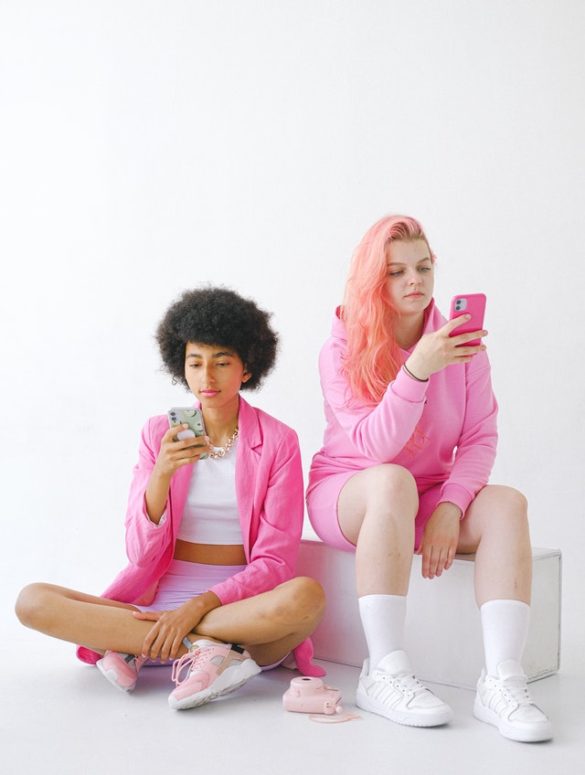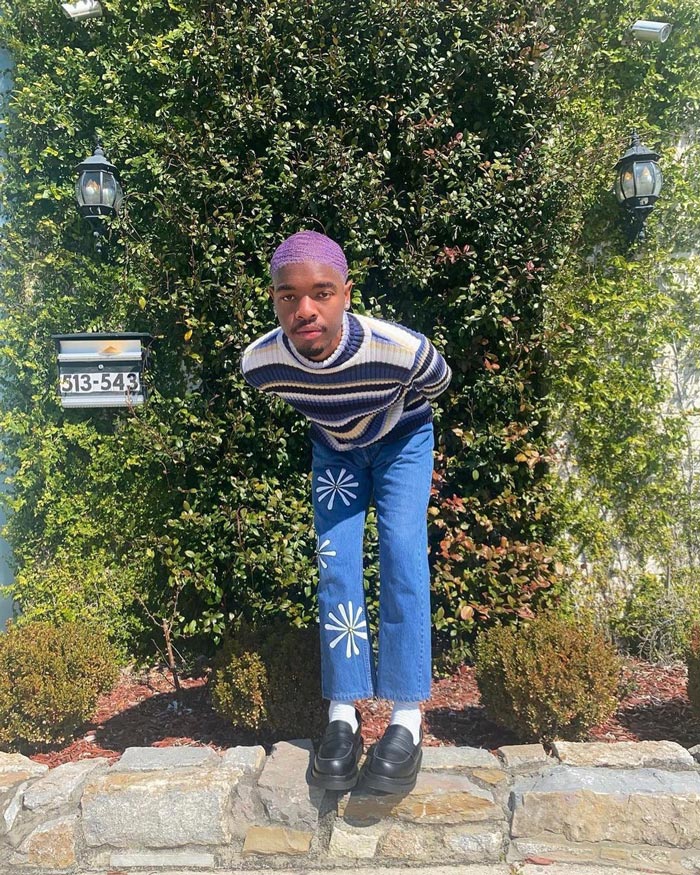An excerpt from ‘Do subcultures still exist? An exploration into the relationship between sustainable fashion, hedonism, and social media within Generation Z.’ by Ella Citron-Thompkins
Cover image by Anna Shvets via Pexels
This study aimed to generate a wider understanding of subcultures and the criteria that must exist for a group to be labelled as such, alongside three prevalent themes established within the culture of Generation Z: sustainable fashion, hedonism, and social media. A comprehensive review of existing literature was followed by the application of two qualitative research methods, which investigated, first-hand, the thoughts, feelings and experiences of those within Generation Z, in relation to the subjects at study. A thematical analysis of the findings was carried out to uncover emerging themes, providing an explanation as to why Generation Z may have adopted the various values, behaviours, and style that they have. Through an exploration of significant discoveries found in both literature and data, this investigation demonstrates how the evident relationship between sustainable fashion, hedonism, and social media within Generation Z may be presented as a subculture through their reflection of the groups’ collective values, behaviours and style.
What is a subculture: values, behaviour and style
Having been a popular topic of research in the past, there has been much discussion over what a subculture is and the criteria that must exist in order for something to be labelled as such. Haenfler (2014) defines a subculture as a set of “motivations, beliefs, and practices“ held by a group of likeminded people. Hebdige (1979) supports this, revealing how subcultures behave in certain ways based on shared beliefs. However, Williams (1965) argues it is much more than this, suggesting that subcultures are, in fact, a “particular way of life” which not only symbolise values and beliefs, but an attitude, displayed through the attributes of the subculture (Lull, 1987). Subcultures are found primarily within youth groups (Haenfler, 2014), and Cashmore (1985) accounts for this as he asserts that “youth subcultures are ways in which young people come to terms with the social order”, perhaps suggesting that they are a way for young people to establish their place in society, while older generations have already done so.
Alongside these core values and beliefs, “each new subculture establishes new trends [and] generates new looks” (Hebdige, 1979) which form, fundamentally, the basis by which a subculture can be recognised. Through the use of style, individuals in these groups can express themselves however they wish, collectively standing out from the rest of society. Hebdige (1979) notes that a key objective of style within subcultures is that of individuality. This style later becomes an identifiable aspect of the subculture and what it stands for, reflecting the values of the group (Gelder, 2007). Previous research into subcultures, such as Skinheads, who exhibited “cropped hair, braces, and steel-toed boots” (Haenfler, 2014), alongside Mods, who wore clothes that were “very tailored” (Rosen, 2020) show the way in which members adopt the same style, or one which symbolises their shared philosophies.
Though, König (1973) addresses what he calls “the central paradox of dress”, uncovering how style within a subculture comprises “a compulsion to change [and] a compulsion to adaptation … to the new kind of style”. This is reinforced by Simmel (1985) who acknowledges “the attraction of differentiation … with that of similarity and conformity” throughout subcultures – ultimately questioning whether the style of a subculture is, indeed, unique or merely conformist.
Considering these varying viewpoints, the extent to which subcultural style is completely unique appears ambiguous. What does seem clear, however, is that “one of the main functions of a distinctive subcultural style is to define the boundaries of group membership as against other groups” (Clarke, 1986) in order to signify what they stand for as a division.
It is largely acknowledged that subcultures are formed in response to societal happenings, adopting certain morals and actions in response. This potentially reflects the zeitgeist (Jenks, 2015); “the spirit … which marks the thought or feeling of a period” (Neiman, 1957), and how it motivates behaviour. This notion coincides with Muggleton (2000) who considers how “subcultures can be regarded as a form of resistance” to the structures of society. Hebdige (1979) suggests how subcultures are a way in which groups can assert their resistance to authority, demonstrated through behaviours which may challenge the norms that they oppose. He goes onto argue that these tensions “between dominant and subordinate groups can be found reflected in … mundane objects which have a double meaning”. For example, he suggests how “humble objects can be magically appropriated; ‘stolen’ by subordinate groups and made to carry ‘secret’ meanings: meanings which express a form of resistance to the order which guarantees their continued subordination” (Hebdige, 1979). This implies how subcultures may take legitimate objects and use them illegitimately in an attempt to challenge the status quo that typically favours the powerful. The Hippy movement provides an example of this defiance as “it manifested itself as a withdrawal from the dominant achievement-orientated values of the puritan work ethic” (Muggleton, 2000).
A generational movement towards sustainable fashion
Generation Z are one of the most eco-conscious generations (Petro, 2020) and are extremely aware of the threats presented by the modern world, particularly the damage caused by fast fashion which significantly contributes to climate change (Tucker, 2019). More than ever before, “traditional retail is being shaken up by the rise of resale” (The Digital Fairy, 2020) and the youth generation are now opting for sustainable fashion (Thomson, 2019) in order to combat this environmental issue. Not only is this active decision to purchase reused goods ethical, it is becoming a trendy alternative as it is an opportunity to find authentic, vintage pieces (Bramley, 2019), often at a lower price to standard retail (Wicker, 2019). This “fits the teen bargain hunt mindset, as well as their concern with climate crisis and eco-friendly fashion” (The Digital Fairy, 2020).
One of the most popular ways in which Generation Z acquires this sustainable fashion is through online selling platform, Depop. With over 6.2 million UK users, equivalent to 1/3 of the country’s Generation Z population (The Digital Fairy, 2020), it aims to provide “a second-hand clothing marketplace [via] social network” (Sutherland, 2018). Users of the site are “driven by environmental sustainability and a penchant for vintage fashion” (Nassauer, n.d.). Successfully catering for its users expectations, the platform sells mostly vintage items, with a huge market for clothing from the 90s and 2000s (The Digital Fairy, 2020). Now recognised by users as the ‘Depop look’, it has been argued that Depop is, in itself, a growing subculture “complete with its own … behaviours, aesthetic, social system, values and economy” (The Digital Fairy, 2020) that some of Generation Z are now a part of.
Alongside its sustainability, a key appeal of clothing purchased on Depop, is that it can “help to create a unique style or look” (Rijs, 2019), allowing for “a certain kind of young shopper to stand out from the crowd” (Sutherland, 2018). This desire for individuality through style, which is a “key component of our identities” (French, 2015), may also present users of Depop as part of a subculture, as Hebdige (1979) has illustrated the main aim of style within subcultures is to seek individualism.
Left: the #gotinondepop hashtag allows users to share their finds on the fashion resale platform (@salemmitchell via @depop). Right: Seller @ahmadjcarswell poses with some of the clothes available to be purchased through his account on the platform (via @depop).
McRobbie (1989) highlights how previous subcultures have also taken inspiration from the past instead of following the mainstream style of their time. He sees this as “a remarkable surge of contemporary fascination with nostalgia” where “different decades are placed together with no historical continuity”. This phenomenon perhaps confirms that part of the attraction of being in a subculture is the rejection of conventional societal norms attained through clothing which allows groups to take inspiration from previous eras to present themselves in an exceptional way (Muggleton, 2000).
Some, however, have rejected ‘Depop style’ as being part of a subculture, as it does not necessarily conform to one particular style, but instead a general scope of vintage fashion differentiated by personal taste and different periods of time. Muggleton (2000) remarks on how clothing may not be worn “for any underlying message” but instead, simply the look. Additionally, some of Generation Z themselves have disputed that they are part of a subculture, claiming they dress for themselves and while they “like the idea of unity”, they do not necessarily agree with the giving of labels (The Digital Fairy, 2020). Whilst it is true that the clothing varies, and people may not be following a particular style when shopping on Depop, the principle behind why they are dressing in this way is apparent through their “deeply held environmental beliefs” (Rijs, 2019) and mutual yearning for sustainable fashion. Thus, reflecting that, albeit indirectly, some of Generation Z are conforming to a style formed upon a shared set of values and beliefs, presenting a generational movement towards recycled fashion.
The environmentally conscious values that Generation Z have mutually adopted in response to the prevalent climate crisis may reflect the concept of capturing the zeitgeist through fashion (Bramley, 2019). This may evoke how youths reject the norms of society through subcultural elements such as style. Muggleton (2000) notes how “young people combine elements of clothing to create new meanings … and sometimes reject the normative definitions of ‘fashion’ promoted by the clothing industry”.
Hedonism at clubs and festivals
Hedonism, defined as “a way of life in which pleasure plays an important role” (Veenhoven, 2013), is frequently associated with festivals and nightclubs which are predominantly common among youths (Hamzah, Suandi, Krauss, Hamzah & Tamam, 2014). Often gathering with friends or like-minded people, Thornton (1995) reveals how “crowds generally congregate on the basis of their shared taste in music … and their preference for people with similar tastes to themselves”. Within Generation Z, there is an interest in electronic music genres which present themselves at popular festivals and clubs where Generation Z can often be found embracing the hedonistic experience. Studies have suggested that festivals and clubs alike provide a cultural experience for visitors, which reflect certain values and behaviours (Hamzah, et al., 2014). Boutique festivals specifically, which cater for the more electronic music tastes, offer a “niche” and “superior” experience (Robinson, 2015), appealing to those who are seeking out extraordinary opportunities, as subcultures do. The way in which crowds flock together at events such as these, reflects some similarity to the way in which subcultures assemble based on similar ideals, such as punks “who would listen to many of the same records and tapes and attend punk shows where they freely interact” (Lull, 1987).
Festivals offer a sense of “freedom and escapism” where “the rules of society [can] be bent, or written anew” (Robinson, 2015). Thornton (1995) strengthens this notion as she recognises that, like festivals, “clubs offer other-worldly environments in which to escape … abandon the [normal] routine” appealing to young people who crave risk and excitement (Hebdige, 1979). While for many this may be a mere form of escapism from the monotony of everyday life, for others this act of hedonism is a conscious practice of disconnect from the moral codes of society – as Robinson (2015) suggests there is “a degree of tension between festival and the dominant systems of capital that reign outside it”. This conveys the belief system of those in attendance and categorises them with a similar train of thought to subcultures that may resist societal rules by challenging authority (Hebdige, 1979).
On the contrary however, research from Statista (2016) on the distribution of age among festival-goers revealed that while festivals are most popular with those aged 18-25, there is a disparity in the age range of attendees. Thus, highlighting that it is not just youth subcultures who seek out hedonistic experiences at clubs and festivals, but older generations too.
How Generation Z use social media
Social media has grown rapidly in recent years, becoming extremely popular amongst Generation Z, who are thought to be “social media obsessive” and “always connected” (The Digital, 2020). With the help of a number of different apps it seems apparent that Generation Z can share every aspect of their life through their phone (Irregular Labs, 2019). For example, Instagram allows users to “build a following” and “socialise” with others online, while sharing extracts of their life through the images they upload (The Digital Fairy, 2020).
Unlike generations before them, Generation Z are “invested in how they portray themselves on social media” (Gil, 2018), striving for ‘social currency’. This is defined as the “acquisition of likes and followers, posting of pictures … and the subsequent rise and fall of status” that is “generated and distributed across platforms” (The Digital Fairy, 2020). The way in which users self-curate their online existence to achieve a unique and esteemed profile (Irregular Labs, 2019) imitates how those in subcultures endeavour to be diverse (Muggleton, 2000), presenting the best version of themselves.
It has been established that within Generation Z “there is a movement … towards being socially conscious” and “politically aware” (The Digital Fairy, 2020). The power of social media has aided this crusade as it has encouraged “activist participation” (The Digital Fairy, 2020), inspiring young people to fight for what they believe in, via the web. This illustrates how people are coming together to act upon their beliefs, much as youth subcultures would (Kennelly, 2009). While previously studied subcultures may not have had access to social media and the internet in the same way that Generation Z do, there is evidence to suggest that subcultures such as the Mods and Rockers practised activism too, for example through protest, though in a more destructive, confrontational manner (Rosen, 2020).
The relationship between sustainable fashion, hedonism, and social media
As we have seen, for a group of people to actually become a subculture they must be united by a reciprocal theme of values, behaviours and style (Hebdige, 1979). The three components examined seem to have presented themselves within Generation Z, creating a common link which is further reviewed below.
Initially, the vast success of the sustainable fashion movement, that is largely down to online resale platforms such as Depop, is effectively unachievable without social media as it is through the advancements of this technology that the behaviour of ethical shopping has been encouraged and sustained (The Digital Fairy, 2020). Combined with this, platforms such as Depop and Instagram focus heavily on curating a unique self-image, “creat[ing] a new dynamic by which to grow a personal brand online”, an activity with which Generation Z seem to be extremely preoccupied.
Secondly, much of the sustainable fashion that is purchased through Depop is popular among party-goers, with frequently used Depop tags such as “Fezzie style” (The Digital Fairy, 2020) directly catering for these groups. This style is then seen at hedonistic events creating a link between the clothes Generation Z are wearing and where they are wearing them to. Having attended these events, Hudson & Hudson (2013) reveal how people are encouraged to “share their experience” online through images on their social media. Festivals, in particular, assist this process by introducing apps which are “integrated with social media, so users [can] … Instagram their way through the festival” (Hudson & Hudson, 2013). When documenting these hedonistic experiences online it is likely that attendees will be sharing their vintage style at the same time, revealing how these interlinking aspects help to aid the self-curation process which is so prevalent among Generation Z (The Digital Fairy, 2020).
Ultimately, this review of literature, along with data from first hand research, demonstrates that the values, behaviours and style of Generation Z exist simultaneously and are mutually generative, indicating that subcultures do indeed still exist and the relationship between sustainable fashion, hedonism, and social media can be classed as such.
Ella Citron-Thompkins (@ellakct) is a London-based fashion writer, also working within fashion communications and PR. She is passionate about encouraging sustainable ways of consuming fashion and discovering brands that put ethics and sustainability at the forefront of their practice. Read all of Ella’s pieces here.





